Introduction
As an integral aspect of the global financial market landscape, Proprietary Trading Firms play an essential role in the Forex market. These independent institutions operate differently from conventional brokerages, offering unique opportunities for traders. This article breaks down these often complex, yet lucrative firm structures, shedding necessary light on their operations and significance in Forex trading.
What Are Proprietary Trading Firms?
Proprietary Trading Firms, often referred to as prop shops, are private companies specializing in trading large volumes of financial instruments including currencies, commodities, equities and bonds. They utilize the firm’s capital to carry out their trades, and their profits and losses affect the firm’s capital directly.
The Structure of Proprietary Trading Firms
Understanding the structure of these firms is vital for any Forex trader. Below is an elaboration of the key components.
Management Level
At the helm of proprietary trading firms is the management level. These are experienced professionals who formulate investment strategies, set risk parameters, and oversee trading operations.
Traders
Next are the traders. They are responsible for executing trades according to the firm’s strategies using the firm’s capital. These are often high-risk trades that average investors or traders would struggle to handle.
Risk Managers
Risk managers play a crucial role in ensuring the firm’s risk exposure is within acceptable parameters. They analyze trade risks and use various risk management tools.
Support Teams
Lastly, support teams encompass analysts who conduct market research, technology experts who maintain trading infrastructure, and administrative staff who ensure smooth operations.
How Trading is Conducted at Proprietary Trading firms
Traders at these firms often engulf in high frequency trading which involves executing multiple trades within microseconds. It’s also notable they are not trading investors’ money but the firm’s capital, thus, the rewards and risks are exclusively for the firm.
Payout Structure At Proprietary Trading Firms
These firms typically operate on a profit-share model. Traders receive a percentage (usually between 50% – 90%) of the profit they earn from a successful trade.
Potential Benefits And Risks Of Among Proprietary Trading Firms
These firms provide opportunities for traders to trade large capital, learn from experienced colleagues and use sophisticated trading software. However, it’s a high-stakes environment that not all traders can thrive in.
How To Select A Proprietary Trading Firm In Forex
When selecting a prop shop, consider factors such as reputation, profit-sharing model, training resources, capital size, technology, and risk management strategies.
Conclusion
Understanding the structure and operations of Proprietary Trading Firms is crucial for anyone involved in Forex trading. These institutions offer exceptional opportunities but also pose significant challenges. Therefore, traders must thoroughly understand their structure and processes before opting to join one. The journey to profiting with these firms involves persistent learning, iron discipline, and meticulous risk management.




